Workshop Report The 7th EU-Japan Young Scholars Workshop / 2024 International New Generation Workshop(2024.11.8-10)2025/01/31
Workshop Report
The 7th EU-Japan Young Scholars Workshop in Alsace
“Transnational Japanese Spaces”
「トランスナショナルな日本の空間」
■Organizers:
・Consortium for Global Japanese Studies (CGJS)
・Hosei University Research Center for International Japanese Studies (HIJAS)
・European Center for Japanese Studies inAlsace (CEEJA)
▶日本語レポートはこちら
From November 8 to 11, 2024, we held the 7th EU-Japan Young Scholars Workshop in Alsace, titled “Transnational Japanese Spaces.” This workshop was co-organized by the Hosei University Research Center for International Japanese Studies (HIJAS) and the European Center for Japanese Studies in Alsace (CEEJA), with generous support from the Consortium for Global Japanese Studies (CGJS). Since 2021, the workshop has extensively engaged with the theme of ‘Japanese Transnationalism,’ starting with “Japanese Studies and Transnationalism,” followed by “Japanese Transnationalism and Empire” the subsequent year, and “Transnational Change in Contemporary Japan” in 2023. The previous workshop, held in 2023, focused on various transnational phenomena in contemporary Japan, with one of the sub-themes being “space” and “place.” We found this topic worth exploring further for this year’s workshop. Thus, we decided to call for papers that examine the formation, development, and representation of “transnational spaces in Japan,” including historical cases from the pre-war period. We reached out to established scholars specializing in urban studies and invited early-career researchers from Europe and Japan. Following a careful screening process, a total of 11 presenters were selected: three from Japanese institutions and eight from European institutions. The selected presenters gathered in Colmar, France, for a three-day intensive workshop to present their work and engage in discussions (for the program, please see here).
The first day of the conference (November 8) featured presentations on cultural studies and education under the title “Virtual/Imagined Transnational Spaces and Education,” with Hideto Tsuboi (Waseda University) serving as the session chair. The event began with a keynote speech by Christophe Thouny (Ritsumeikan University), titled “Planetary Imaginations of Postwar Japan,” in which he introduced a “planetary” approach to understanding Japanese culture. His talk centered on how “planetary imaginations” (alongside “images of urban fortresses” as its counterpart) have been represented in postwar Japanese popular culture through an analysis of the manga “Boku no Chikyū wo Mamotte (Please Save My Earth),” published from 1986 to 1994. After the keynote, four additional presentations followed. First, Koto Nishimura (Waseda University) analyzed Junichiro Tanizaki’s novel “Gourmet Club,” which tells the story of a Chinese restaurant in Kanda, Tokyo. Referring to the political context of Japan-China relations at the time, Nishimura discussed the significance of “eating transnationalism” in transcending national boundaries. Next, Kuriko Shinozaki (University of Strasbourg) examined a unique boarding school, Lycée Seijo, that once operated in Alsace and analyzed the success and challenges of the transnational practices for the students who attended the school. The third presenter, Noah Hinschberger (University of Strasbourg), explored virtual transnational spaces where Vtubers utilize Japanese popular culture to teach the Japanese language. As a concluding presentation for the first day, Maj Hartmann (KU Leuven) analyzed privacy laws, which provide a legal foundation for forming virtual transnational spaces. She examined the role of social movements since the 1970s in raising awareness of privacy rights.
The session on the second day was titled “History of Japanese Transnational Spaces,” with Regine Mathias (CEEJA) serving as chair. The keynote speaker for this session was Katja Schmidtpott (Ruhr University Bochum), who specializes in Japanese urban history. Schmidtpott delivered a lecture entitled “Transnational Approach to Japanese Urban History,” in which she presented the concept of “transnational urban history,” viewing cities as sites and actors in the flow of people, information, technologies, capital, and ideas that connect and disconnect the globe. She then shared various examples, from international conferences on urban design, highlighting exchanges between Japanese and European architects to representations of Japanese architecture in books and magazines published in the West. In conclusion, she made an important observation that while Japanese transnational urban studies have primarily focused on the relationships between Japan and the West, the connections between Japan and the rest of Asia remain underexplored. The first presentation after the keynote was by Andreas Eichleter (Heidelberg University), who examined early modern Yokohama as a transnational space through maps, images of interactions between local Japanese and Western merchants, and local English newspaper reports. The next presenter, Paride Stortini (Ghent University), focused on the transnational linkage between Karayuki-san, who was sold from Japan to Southeast Asia as a prostitute in the late 19th century, and Buddhist monks traveling from Japan to India on pilgrimage. Stortini described the Tennyotō memorial pagoda in Amakusa as a “space of transnational memory” constructed as a response to such contingent encounters. The following presentation by Datong Qiu (Heidelberg University) focused on Hakodate during the Meiji period, analyzing how Chinese merchants strategically leveraged Western merchants’ reputation, influence, and advantageous legal status in Japan to obtain the lease to the land for building Chinese Guild Hall.As the final presentation for the second day, Manon Ramos (Kyoto University) explored early modern Japanese univesity as an example of transnational knowledge space. Ramos compared two transnational spaces in the universities: the library, which collects books from abroad, and lecture halls where foreign scholars bring in knowledge.
On the final day, three presentations were delivered under the session title “Transnational Spaces in Contemporary Japan” (chaired by Kei Takata). First, Marius Palz (Oxford University) examined the issue of PFAS emissions from the U.S. military base in Okinawa. He highlighted the transnational nature of PFAS, which spreads beyond national borders, and the potential for cross-border movements against pollution. The next presenter, Frank Tu (Free University of Berlin), focused on the regional development strategy of Buzen City, a small town in Fukuoka Prefecture. He investigated the mayor’s leadership in welcoming Vietnamese immigrants and the responses of local residents to this transformation. For the final presentation, Gijung Song (Nagoya University) discussed the career development of second-generation Japanese-Brazilians based on fieldwork at the Homi housing complex in Toyota City, where many Japanese-Brazilians reside. She emphasized the significance of “local transnationalism,” whereby multicultural actors connect Japanese and Brazilian communities at the local level. Following these various presentations over the three days, a summary discussion was held to conclude the workshop. At the beginning of the discussion, Kei Takata provided the following summary to foster further methodological development while linking the presentations and discussions from previous workshops to this year’s event.
While reviewing this workshop, we can summarize that all the presentations consisted of two elements: “space” and “things that move across national borders.” Various “spaces” of different scales were discussed, such as the school (Shinozaki), restaurant (Nishimura), guild hall (Qiu), tower (Stortini), universities (Ramos), housing complex (Song), military bases and surrounding areas (Palz), towns (Tu), cities (Eichleter), and virtual spaces (Hinschberger). For “things that move across national borders,” the discussion covered a wide array of tangible and intangible “things” such as people (Shinozaki, Song, Tu, etc.), knowledge (Ramos), information (Eichleter), policy (Hartmann), language (Hinschberger), memory (Stortini), cuisine (Nishimura), toxic substances (Palz), among others. Thus, the study of “transnational spaces” is literally a combination of these two elements. Furthermore, if we analyze the presentations from a different perspective, we can observe that each project has addressed the following aspects of “transnational spaces” in one way or another. The first is the “constitution” of transnational space; in other words, research that focuses on how transnational spaces are created. The second is the transnational actions that were “practiced” in a given space, with a typical example being the interaction between Japanese and foreigners. The third involves analyzing the “representation” of transnational spaces in fictional writings, news reports, and virtual media. Finally, although it was not as evident as other perspectives, one can also consider research examining the “impact” of transnational practices on certain spaces or how the constitution of transnational spaces has brought about “changes” in the larger society.
To be sure, these four elements are often intertwined and not clearly distinct in actual research. Nevertheless, I believe that categorizing these approaches will help researchers better grasp what they aim to discover. In fact, as we frequently heard during our previous workshops, the transnational approach has faced criticism for its conceptual ambiguity. In the discussion, Christophe Thouny also made the important observation that “transnationalism is everywhere.” While ‘transnationalism’ can be defined in contrast to related concepts like ‘global’ or ‘international’ (for details, see Kei Takata, “Toward Transnational Japanese Studies,” International Japanese Studies, No. 20), a closer examination of case studies, as demonstrated in the workshop presentations, reveals a variety of distinct transnational realities that may appear unrelated to one another. While each transnational phenomenon is fascinating in its own right, it can sometimes be challenging to understand the implications of the specific cases studied. In other words, the arguments scholars derive from transnational phenomena can sometimes lack clarity. Perhaps such a downside, in part, may be due to the ambiguity of the transnational concept.
Then, what are the ways to overcome such downside? One way is to bring in a macro perspective and link the cases to broader social and political projects. For instance, the transnational practices during the Meiji period were often tied to the modernization project, especially in relation to state formation. In contrast, the transnational social movements that emerged during the postwar period of the 1960s and 1970s sought to dismantle or at least deconstruct the nation-state framework. Introducing a macro perspective in this manner can help one consider which broader project the case study belongs to. This approach also facilitates comparisons with other cases within the same social and political project, thereby highlighting the uniqueness and significance of your case as distinct from others. Another strategy is to combine transnationalism with related concepts. Recently, many concepts that align with transnationalism have been developed or updated. These include but are not limited to networks, mobility, interaction, infrastructure, capital, and others, all of which are concepts that help to describe different aspects of transnational practices. Conversely, some concepts address the obstacles to transnationality or its unintended consequences, such as boundaries, disjuncture, decoupling, and contingency. While the concept of transnationalism alone may not be sufficient to clearly define the contours of transnational cases, combining these concepts allows scholars to attain a more precise and clearer understanding of what their cases imply.
In summary, the captivating presentations and engaging discussions at this workshop generated numerous ideas that will foster further research on Japanese transnationalism. We also improved the organization and coordination of the workshop by learning from past experiences. It is not an easy task to invite a variety of presenters from Japan and Europe, select papers that suit the theme, and facilitate innovative discussions while connecting them to the knowledge gained from past workshops. This year’s workshop appeared to be quite successful, as each element came together to create a sense of cohesiveness among the participants even before. Also, at the “backstage” of the workshop, we observed many fruitful communications involving presenters, organizers, and keynote speakers. Participants were, for instance, exchanging information and thoughts on differences in academic cultures between Japan, Europe, and beyond, as well as the opportunities for transnational career development, which will ultimately advance the future of Japanese studies.
The following commentators participated in this year’s conference and provided valuable feedback from time to time.
Josef Kyburz (CNSR), Masashi Oguchi (Hosei University), Nozomi Takahashi (University of Strasbourg), Tsutomu Hoshino (Hosei University), Yasuko Yokoyama (Hosei University), Yusuke Suzumura (Meijo University) [alphabetical order]
Finally, I would like to express my gratitude once more to the CEEJA staff for hosting us in Colmar this year.
Kei Takata (Hosei University)
 Right: Opening Remarks by Prof. Regine Mathias (CEEJA)/ Center: keynote speaker, Prof. Christophe Thouny |
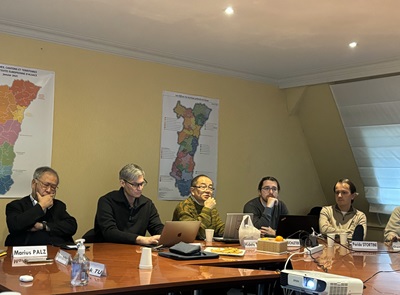 A day at the conference 1 |
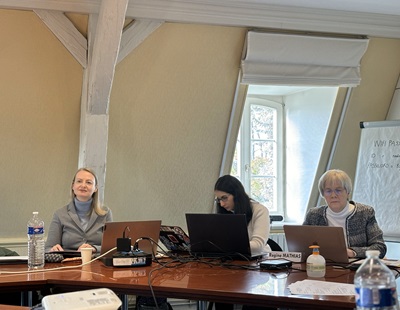 Keynote speech by Prof. Katja Schmidtpott |
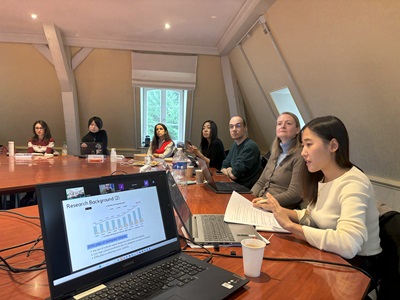 A day at the conference 2 |
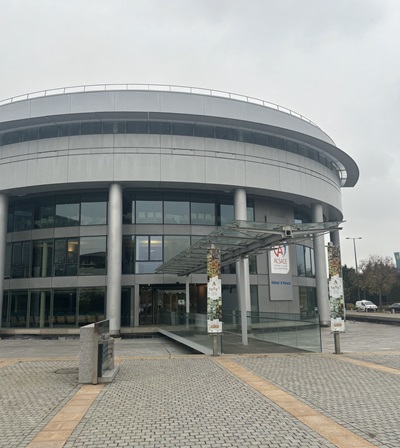 Conference Venue (first day, Collectivité européenne d’Alsace building) |
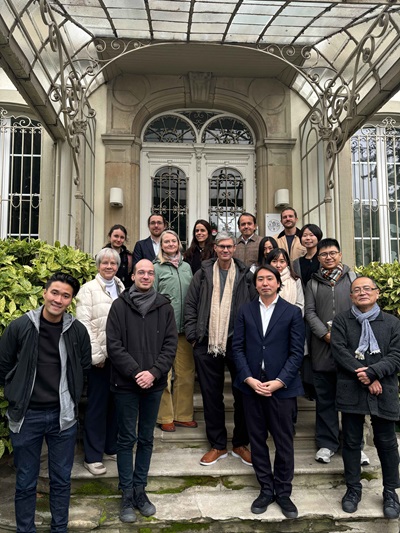 Participants in front of the conference venue (for the second and the third day) |

